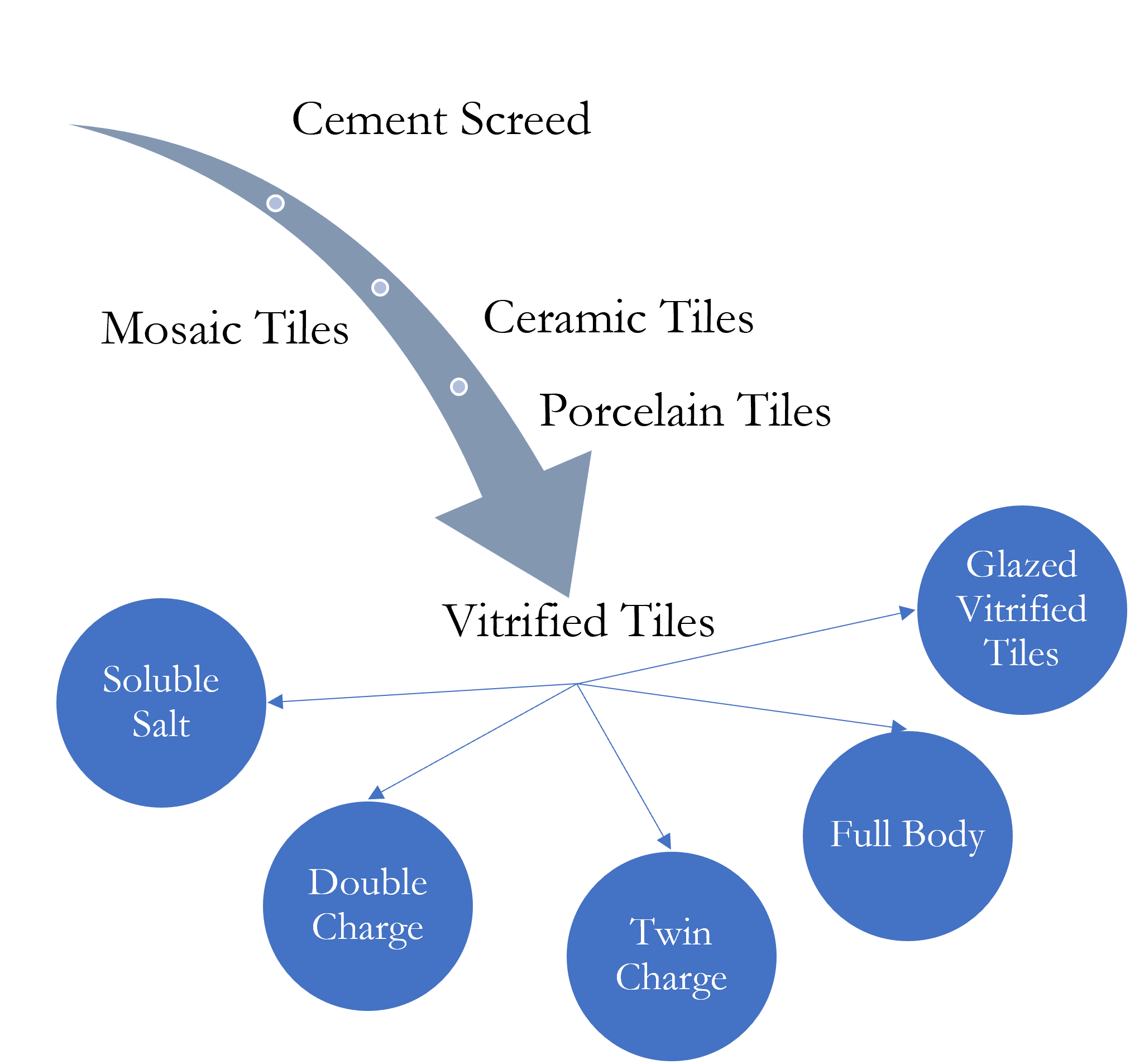This article explores the various types of vitrified tiles such as Soluble salt, Double Charge, Glazed Vitrified Tiles, and Full body Vitrified tiles. The articles explore the usage of these tiles in different applications and use cases.
Vitrified tiles are a type of ceramic tile that has been processed through vitrification. Vitrification involves the firing of the tiles at extremely high temperatures, which causes them to become non-porous and glass-like in nature. This process creates a dense, hard surface that is highly resistant to water absorption, stains, and scratches. They are known for their durability, strength, and low maintenance requirements. They are commonly used in both residential and commercial settings for flooring and wall applications.
Explore on Housing Plan Designs – Getting Your Dream Home Right
There are several types of vitrified tiles available in the market. Some common types include:
-
Full-body vitrified tiles: These tiles have a consistent composition throughout, with the color and pattern extending from the surface to the core. They are highly durable and suitable for high-traffic areas.
-
Double-charge vitrified tiles: These tiles are created by applying two layers of pigments during the manufacturing process. This results in a pattern or design on the surface of the tile. They are known for their aesthetic appeal and are often used in decorative applications.
-
Glazed vitrified tiles: These tiles have a layer of glaze applied on top of the vitrified body, giving them a glossy or matte finish. The glaze adds an extra layer of protection and enhances the visual appeal of the tile.
-
Polished vitrified tiles: These tiles undergo a process of polishing after firing, which gives them a shiny, reflective surface. They are often used to create a luxurious and elegant look.
-
Digital vitrified tiles: These tiles are manufactured using digital printing technology, allowing for a wide range of patterns, designs, and textures. They can replicate the look of various natural materials such as wood, stone, and marble.
These are just a few examples of the types of vitrified tiles available, and there may be other specialized variants as well.
Classification of tiles as per IS 15622 and ISO 13006

Exploring Double Charge, GVT, PGVT, and Full Body Vitrified Tiles for Your Space
In the field of interior design and building, tiles significantly impact how aesthetically pleasing a space looks. With the enormous variety of tiling options, it’s quite obvious to get lost in a sea of confusion.
This blog will explain the distinctive qualities and varied uses of four popular tile types: Double Charge, GVT (Glazed Vitrified Tiles), Polished GVT, and Full Body Vitrified Tiles. Join us as we discover how these tiles can turn your living and working spaces into extraordinary works of art as we delve into the realm of tile craftsmanship and learn what distinguishes these tiles from each other.
What is Double Charged Vitrified Tiles?
The durability and strength of double-charged vitrified tiles have made them a popular choice for flooring. They are often thicker than regular tiles and are created by melting two layers of pigment. The tile’s durability and luster are increased during the vitrification process, providing the spaces where you install a polished appearance.
They are flexible and can be utilized in various applications and styles. They are popular for both residential and commercial usage.
Here are a few typical uses for double-charged vitrified tiles:
- Bedrooms and Living Rooms: Due to their stunning aesthetics and capacity to reflect the natural light that enters these places, these tiles are a perfect example of having highly polished floor tiles in living rooms and bedrooms. This makes the spaces appear and feel larger.
- Kitchens: They are perfect for use in kitchens since they are easy to maintain and resistant to dust and filth.
- Outdoor Spaces: They are appropriate to be used in outdoor spaces due to their strength and ability to handle considerable foot traffic.
- Industrial and Commercial Settings: Given that they are designed to withstand extreme wear and tear, these are the best choice for commercial and industrial situations with significant foot traffic.
What is a GVT tile?
Glazed Vitrified Tiles or GVT, is a kind of tile that is created by glazing a vitrified body and fusing the two. The glaze layer imparts the tile’s color and design. GVT tiles are renowned for their strength, resilience to stains and scratches, durability and ease of cleaning and maintenance.
GVT tiles come in a range of designs and finishes, including matt and glossy ones. They can be utilized as floor tiles, wall tiles, and for other purposes in residential and commercial settings. GVT tiles are a preferred option among consumers because of their eye-catching appearance and durability.
Here are a few typical uses for GVT:
- Commercial spaces: Due to their longevity and resistance to foot traffic, GVT tiles are widely utilized in commercial spaces such as corporate offices and hotels.
- Residential spaces: Residential spaces, such as living rooms, bedrooms, and kitchens, can also benefit from the usage of GVT tiles.
- Walls: Glazed Vitrified Tiles, especially huge slabs of GVT tiles, can be utilized on walls.
What are Polished GVT?
A type of vitrified tile with a polished surface and a high reflecting index is known as Polished Glazed Vitrified Tiles (PGVT). PGVT tiles have a digitally printed design that gives them a glazed look. They are highly polished tiles. They resemble GVT tiles, except that they have a gloss surface because of an additional layer of polish applied to them.
Here are some popular uses of PGVT tiles:
- Living rooms and Bedrooms: PGVT tiles may shine and reflect light thanks to their glossy surface and high reflecting index, making them ideal for usage in living rooms and bedrooms.
- Kitchens and Bathrooms: PGVT tiles are perfect for use in kitchens and bathrooms since being less porous they are less water absorbent and simple to maintain and clean.
- Commercial spaces: For their longevity and ability to withstand heavy foot traffic, PGVT tiles are often utilized in commercial sectors such as corporate offices and hotels.
- Outdoor Spaces: Due to their resilience to scratches and stains, PGVT tiles can also be utilized in outdoor spaces like patios and balconies.
Learn about Marble : Their types and sources of Origin
What is Full-body Vitrified Tiles?
Full-body vitrified tile is a type of vitrified tile having a pigment through the entire thickness or body of the tile. This makes them a perfect option for high-traffic areas because of their high resistance to stains, wear and tear, and scratches.
They never fade throughout their life because their color is consistent throughout their thickness. They are used in high-traffic spaces and are scratch-resistant. Also, they come in many different styles, designs, and sizes and can be used in residential and commercial settings. Due to their longevity and resistance to wear and tear, they are frequently used as flooring tiles in high-footfall areas.
Here are the most popular uses of full-body vitrified tiles:
- High-traffic areas: Because of their endurance and resilience to wear and tear, they are the best option for high-traffic areas such as hospitals, offices, malls, and restaurants.
- Outdoor Spaces: They are frequently utilized in outdoor spaces due to their water resistance.
- In residential spaces, such as living rooms, bedrooms, kitchens, and bathrooms, you can use full-body vitrified tiles.
- Commercial spaces: Due to their sturdiness and resilience to foot traffic, they are widely utilized in commercial sectors such as corporate offices and hotels.
Difference between Vitrified Tile and Ceramic Tiles?
Vitrified tiles are made from a mixture of clays and other materials that are fired at a high temperature to create a dense, hard surface that is resistant to moisture and staining. Ceramic tiles are also made from clay and other materials but are fired at a lower temperature, resulting in a more porous surface that is more prone to moisture and staining. Vitrified tiles have a glossy finish and are generally stronger and more durable than ceramic tiles.
Both Vitrified tiles and ceramic tiles are made from clay, but there are some key differences between them:
-
Composition: Vitrified tiles are composed of a mixture of minerals, including silica, clay, and feldspar. This blend undergoes vitrification, transforming it into a glass-like material. On the other hand, ceramic tiles are made primarily from clay mixed with other natural materials, such as sand and water.
-
Manufacturing process: Vitrified tiles are produced using a process called vitrification, where the tile mixture is pressed under high pressure and fired at high temperatures exceeding 1200 degrees Celsius. This results in a dense, non-porous, and glass-like material. Ceramic tiles, on the other hand, are typically fired at lower temperatures, resulting in a less dense and more porous tile.
-
Porosity: Vitrified tiles have a very low porosity level, meaning they absorb very little water. This makes them highly resistant to stains and easy to clean. Ceramic tiles, on the other hand, have a higher porosity level and may require sealing to prevent water absorption and staining.
-
Strength and durability: Vitrified tiles are known for their high strength, hardness, and resistance to wear and tear. They are more durable than ceramic tiles and can withstand heavy foot traffic and other impacts. Ceramic tiles are generally less durable and more prone to chipping or cracking.
-
Application: Vitrified tiles are often used in high-traffic areas, such as commercial buildings and outdoor spaces, due to their durability and resistance to stains and abrasion. Ceramic tiles are commonly used in residential areas for wall and floor applications where there is less foot traffic.
-
Cost: Vitrified tiles tend to be more expensive than ceramic tiles due to their manufacturing process and superior qualities.
It’s worth noting that the terms “vitrified tiles” and “ceramic tiles” can sometimes be used interchangeably, and there is a wide range of variation within each category. The specific properties and characteristics of a tile can vary depending on the manufacturing process, quality, and design.
Conclusion
In conclusion, it is essential to understand the differences between Double Charge, GVT, Polished GVT, and Full Body Vitrified Tiles to make wise interior design choices. Double Charge tiles are durable and need little upkeep, making them perfect for high-traffic areas. GVT tiles have many different design alternatives, and Polished GVT tiles have a more opulent feel. Strong and adaptable Full body vitrified tiles can be used in both interior and exterior areas. Understanding these distinctions allows you to design stunning, durable, and practical places that meet your unique demands.
Also learn Types of paint : Choose the best for your home
Click here to explore other interesting topics from greenarchworld.





